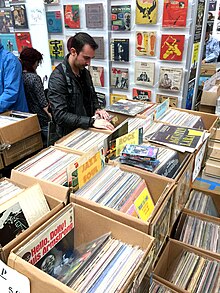
The vinyl revival, also known as the vinyl resurgence, is the renewed interest and increased sales of vinyl records, or gramophone records, that has been taking place in the music industry. Beginning in 2007,[1][2] vinyl records experienced renewed popularity in the West[3][4][5] and in East Asia[6][7] amid steadily increasing sales, renewed interest in the record shop, and the implementation of music charts dedicated solely to vinyl.[8]
The analogue format made of polyvinyl chloride had been the main vehicle for the commercial distribution of pop music from the 1950s until the 1980s when it was largely replaced by the cassette tape and then the compact disc (CD). After the turn of the millennium, CDs were partially replaced by digital downloads[9] and then streaming services. However in the midst of this vinyl record sales were increasing and was growing at a quick rate by the early 2010s, eventually reaching levels not seen since the late 1980s in some territories. Despite this, records still make up only a marginal percentage (8% in the US as of 2023) of overall music sales.[10] Alongside these there has also been a swift increase in the sales and manufacturing of new record players/turntables.[11]
The revival peaked in the 2020s decade, with various publications and record stores crediting Taylor Swift with driving vinyl sales.[12][13][14][15] For 2022 the Recording Industry Association of America reported that: "Revenues from vinyl records grew 17% to $1.2 billion – the sixteenth consecutive year of growth – and accounted for 71% of physical format revenues. For the first time since 1987, vinyl albums outsold CDs in units (41 million vs 33 million)."[16] The revival has been relatively muted in certain other countries like Japan and Germany — the world's second and third largest music markets after the U.S.[17] — where CDs continue to outsell records by a significant margin as of 2022.[18][19]
- ^ Allen, Katie (16 July 2007). "Back in the groove: young music fans ditch downloads and spark vinyl revival". The Guardian. Retrieved 12 August 2022.
- ^ "Infographic: The LP is Back!". Statista. 6 January 2014. Retrieved 16 July 2017.
- ^ Cite error: The named reference
:3was invoked but never defined (see the help page). - ^ "Vinyl revival: LPs to get their own official chart". The Daily Telegraph. Retrieved 16 July 2017.
- ^ Wunder, Jörg (9 October 2008). "Vinyl lebt: Die Welt ist eine Scheibe" [Vinyl lives: The world is a disc]. Der Tagesspiegel. Retrieved 2 February 2020.
- ^ St. Michel, Patrick (11 April 2017). "Hard-core vinyl fans are fueling a revival in obscure Japanese music from the 1980s". The Japan Times. Retrieved 11 April 2017.
- ^ "The rise and charms of LP bars in South Korea". The Economist. Seoul. 18 February 2021. Retrieved 18 February 2021.
- ^ "UK's first official vinyl chart launched as sales rise". BBC News. 12 April 2015. Retrieved 4 May 2024.
- ^ Halliday, Josh (6 January 2012). "Digital downloads overtake physical music sales in the US for first time". The Guardian. ISSN 0261-3077. Retrieved 4 May 2024.
- ^ "Infographic: Despite Comeback, Vinyl Is Still Far From Its Glory Days". Statista Daily Data. 19 April 2024. Retrieved 4 May 2024.
- ^ Staff, Noisey (4 January 2016). "The Resurgence Is Real: British Entertainment Chain HMV Sold One Turntable Per Minute in the Build Up to Christmas". Vice. Retrieved 6 May 2024.
- ^ DiGiacomo, Frank (8 June 2021). "Hip-Hop, R&B And Pop Challenge Rock's Vinyl Dominance In 2021". Billboard. Archived from the original on 7 November 2021. Retrieved 16 July 2021.
- ^ Young, Alex (20 January 2022). "Taylor Swift, the indisputable Queen of Vinyl, named 2022 Record Store Day Ambassador". Consequence. Archived from the original on 19 November 2022. Retrieved 6 March 2022.
- ^ Millman, Ethan (6 March 2024). "How Taylor Swift Took Over Your Local Record Store". Rolling Stone. Retrieved 6 March 2024.
- ^ "Taylor Swift-led vinyl revival recognised by price data gurus". BBC. 11 March 2024. Retrieved 25 March 2024.
- ^ "Year End Music Industry Revenue Report". RIAA.com. Retrieved 16 March 2024.
- ^ "RIAJ Yearbook 2015: IFPI 2013, 2014. Global Sales of Recorded Music" (PDF). Recording Industry Association of Japan. p. 24. Archived (PDF) from the original on 16 June 2015. Retrieved 7 June 2015.
- ^ "3 observations on… how Japan's music industry caters to (and relies on) 'superfans' more than any other market". Music Business Worldwide. 23 October 2023. Retrieved 3 May 2024.
- ^ "Statistik | Absatz von physischen Tonträgern und digitalen Musikprodukten". miz.org (in German). Retrieved 3 May 2024.